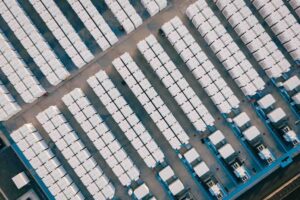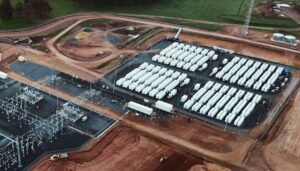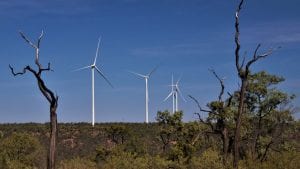John Hewson has launched an extraordinary attack against the main solar thermal technologies that most experts expect to lead Australia to a zero-carbon energy system, saying that the technology is out-dated and nearly “unbankable”.

The former opposition leader, who has become a prominent campaigner for climate action and renewable energy, made the comments in his new role as executive chairman of Solastor Australia, which he boasts has developed the world’s cheapest 24/7 solar technology, using graphite as its storage medium.
But his comments about rivals, particularly a competing 110MW project using molten salt storage technology, have raised alarm bells in the industry, and caused fears that he could set the sector back rather than forwards.
It also comes as new details emerge about the mixed record of his group’s own projects, and the status of the technology that was once described as an “expensive way to boil water.”
At the launch of Solastor’s proposed 170MW project in Port Augusta on Tuesday, Hewson was damning about his competition, comparing molten salt storage technologies to the all-but-redundant Blackberry, describing them as inefficient and expensive, and saying they would be difficult to finance.
Standing next to South Australian premier Jay Weatherill, who will make a decision in coming weeks on whether to issue a contract for SolarReserve’s 110MW solar tower with molten salt storage project in Port Augusta, Hewson told reporters:
“It (molten salt technology) is getting close, I’m told, to being unbankable … it has a lot of inefficiencies. It is much more expensive.”
His comments about costs have raised eyebrows, considering that a 50MW project proposed by SolarStor in Cyprus is forecast by his own company to have similar costs to a 110MW SolarReserve project in South Africa.
But the fact that Hewson has attacked the rival technology in the middle of a funding round being conducted by the South Australia government, and ahead of promises by both the federal Coalition and Labor to prioritise solar thermal projects in the new government, has raised concerns.
As Opposition climate and energy spokesman Mark Butler said at the launch, Australia has been trailing the world on the implementation of solar thermal technologies. “One of the disappointing facts has been failure of solar thermal technologies to get a foothold in Australia,” he said. “It looks like that is finally happening.”
Or maybe not. Solar thermal is considered to be a key technology in the coming energy transition, and critical to 100 per cent renewable energy scenarios considered and proposed by the likes of the Australian Energy Market Operator, the Institute of Sustainable Futures, UNSW, Beyond Zero Emissions and WWF.
But all the solar thermal storage projects being proposed in Australia, indeed the world, apart from Solastor’s, would use molten salt storage, and most propose to use the big solar towers vilified by Hewson’s company.
Hewson’s attacks didn’t stop at labelling the competition unbankable and inefficient. The company’s documents, as we revealed on Tuesday, also claimed that solar towers, and SolarReserve’s in particular, killed birds. He also said the technology was a threat to pilots, was a fire risk, and required gas generators to back up the plant and heat up the salt. All those claims are firmly rejected, and have dismayed supporters of the proposed solar tower projects in the Port Augusta area.
Hewson’s suggestion that molten salt is a dead technology also goes against evidence that shows numerous molten salt storage facilities, pared with both parabolic trough and solar towers, being contracted and financed in South America, South Africa and Morocco.
These involve the Spanish companies Sener and Abengoa, and the US company SolarReserve, which last year built the 110MW Tonopah solar tower and molten salt storage facility, and also also signed a memorandum of understanding with Shenhua to build 1,000MW of similar plants projects in China. It has a contract to build a plant in South Africa at around US12c/kWh.
All these companies, including Vast Solar, an Australian company that also uses solar tower and molten salt technology, and is planning to build a 30MW facility at Jemalong in NSW, are exploring project opportunities in Australia.
By comparison, the record of Solastor – both overseas and in Australia, has been mixed at best, with projects either not proceeding or delayed. Solastor Australia is jointly owned by Solastor Pty Ltd and Momentum Energy & Resources, and has the rights to the technology in Australia.
In early 2012, Solastor won up to $3.5 million in state funding to help finance a small 1.5MW plant in the Midwest region of Western Australia. We wrote about it here, and the press release is here, but the project never happened.
Karen Chappel, the mayor of Morawa shire, where the project was to be based, said the project was dropped because the costs had “blown out from $16 million to $24 million. “It was too big for a small council like ours,” she told RenewEconomy this week. “It had merit, but it also needed diesel backup. It was beyond our means.”
Solastor’s joint venture partner in that project, Perth-based Carbon Reduction Ventures, agreed that the project foundered when the council withdrew support, although CEO Robert Coltrona told RenewEconomy this week that this was the fault of council for wanting a bigger system.
CRV then proposed to use the technology in a “hybrid” system to trap waste heat for use in a WA mine, but that also fell through, Coltrona said, when finance could not be obtained. “We were seeking someone to vendor finance it, but we couldn’t find any.” He said he liked the technology. “The principal makes a lot of sense. It is efficient in storing heat. That was why we put in a lot of time and resources.”
 Two European projects are also yet to see the light of day. A 25MW project in Cyprus, the EOS Thermal Solar Project, was said to have begun earth works in early 2012, and a glossy brochure posted in February, 2012, (you can still see it here), asked investors to pay €10,000 euros to join a syndicate funding what was then described as a €296 million project, and promised all the money back and overall profits of €656 million ($A1 billion) over the life of the project.
Two European projects are also yet to see the light of day. A 25MW project in Cyprus, the EOS Thermal Solar Project, was said to have begun earth works in early 2012, and a glossy brochure posted in February, 2012, (you can still see it here), asked investors to pay €10,000 euros to join a syndicate funding what was then described as a €296 million project, and promised all the money back and overall profits of €656 million ($A1 billion) over the life of the project.
RenewEconomy can find no further reference to that project, although the links remain. Confusingly, the brochure claimed the project would involve two 25MW plants, with one as back-up. However, with the same partners, Alfa Mediterranean Enterprises and and Vimentina, Solastor then won a European Investment Grant in March, 2014, under the NER300 program for a 50MW plant in the same area.
The project received press in CSP Today in April, 2014, in the Greek press in June, and in the Cyprus press in September, where Alfa Medierranean’s Andreas Ioannou suggested the plant would begin construction in November, 2014, begin producing electricity in 2016 (at a cost of 13 Euro cents an hour, after a 60 million euro grant, and be fully complete in 2017.

That didn’t happen. This NER300 project update document (see page 6) suggests the project, along with others, has been granted a “grace period” extending its allowed deadline to between 2020 and 2025. According to this local media report, Alfa took legal action against the head of the Cyprus department of energy, Stelios Himonas, (right) who suggested that funding be reduced if the plant could not meet production targets in the allocated time.
The CSP Today article – quoting an un-named Solastor source, also made mention of projects in Oman (7.5MW) and Chile (5MW) which the company had been working on. The EOS Cyprus project page also makes mention of these projects, but no further reference can be found.
(RenewEconomy sought comment and clarification on all these projects by email and phone from Solastor Australia, but has received no response. RenewEconomy been informed by Hewson that the company will not talk to us after we challenged the claims made by Solastor against molten salt technologies, namely that it had killed birds, was a fire risk and required back up gas generation.)
Solastor Australia’s presentation slides delivered on Tuesday, and posted on its web-site, makes mention of the 50MW Cyprus project, which it says will now begin construction in 2016. It also cites a 60MW project in Crete, without providing further information.
Neither the Cyprus nor the Crete project, nor for that matter its Chinese demonstration plant mentioned below, appears in the solar thermal project database run by the US Department of Energy’s National Renewable Energy Laboratory, considered to be the world’s most comprehensive.
 The Solastor presentation also provides this comparison (above) between the Cyprus project and SolarReserve’s Crescent Dunes project. But SolarReserve says its capital costs were $US730 million, not $US1 billion, and it is on the public record that it is contracted to supply power to Nevada utility at $US135/MWh.
The Solastor presentation also provides this comparison (above) between the Cyprus project and SolarReserve’s Crescent Dunes project. But SolarReserve says its capital costs were $US730 million, not $US1 billion, and it is on the public record that it is contracted to supply power to Nevada utility at $US135/MWh.
In any case, says Dylan McConnell, from the Melbourne Energy Institute, it is very unusual to describe installed cost based on a single year’s output. He also queried the company’s claimed 98 per cent capacity factor.
Another expert said such projects assessments were “non standard” – costs were usually estimated over life-time of the project, or the upfront cost per unit of capacity, not output. But the key was in the delivered price, and the cost of the power purchase agreement.
In Chile, molten salt technology projects have been bid below $US100/MWh by Abengoa and Dubai last week said it was expecting bids of less than $80/MWh for the first round of its 1,000MW of CSP projects (with molten salt storage).
The one SolaStor graphite block project that has operated for a period of time is the 3MW Lake Cargellico plant in western NSW, which used the original patented technology, and which is cited in the Solastor presentation.
In 2013, at an international symposium on solar thermal technology at the CSIRO in Newcastle, Gary Braddock, the chief operating officer of Graphite Power, the company running the plant, described the technology as an “expensive way to boil water.”
He said that unlike other CSP technologies, such as molten salt storage, graphite did not have the cost structure to be able to install stand alone plants. Like CRV’s Coltrona, he thought the technology would be useful supplying waste heat to mines and other remote locations.
Clearly, something has changed in the last few years that has enabled the technology to morph from an “expensive way to boil water” to become the cheapest source of 24/7 solar power in the world, as Hewson and Solastor now claim, and to give them confidence to propose a stand-alone plant of 170MW in Port Augusta, without subsidy, without a contract, and with a single bank reportedly ready to finance the lot.
 The company says it has improved the design of its towers, and achieved a significant lift in the efficiency of its heliostats (mirrors). Less heliostats, it notes, means less capital cost.
The company says it has improved the design of its towers, and achieved a significant lift in the efficiency of its heliostats (mirrors). Less heliostats, it notes, means less capital cost.
Solastor also says it has licenced its technology to a “major Chinese corporate” which it says has been operating a 5MW demonstration plant next to a factory in China since early last year. It does not name its partner, the name of the factory or the location, and it does not provide data on how it has performed. It offered a series of photos of that plant in its media materials, including this one to the right. Again, RenewEconomy asked for further details but none were provided.
Certainly, the technology has captured the imagination of the politicians who were drawn by Hewson’s political cachet to be in Adelaide for the launch.
Butler said it was “great technology”, federal environment minister Greg Hunt said this technology would “provide the pathway” to South Australia becoming the “solar state”. Premier Weatherill described it as a “fantastic piece of technology, that will allow South Australia to take a leadership role.”

 The Solastor document (excerpt above) says that the project already “has the financial support” of the federal government. That’s not quite right – as both the CEFC and ARENA confirmed to RenewEconomy – but Hunt (tweeting enthusiastically at right) also said he would facilitate talks with the CEFC and had already “commended” the project to the chairs of both the CEFC and the new Clean Energy Innovation Fund, which will come into being in July.
The Solastor document (excerpt above) says that the project already “has the financial support” of the federal government. That’s not quite right – as both the CEFC and ARENA confirmed to RenewEconomy – but Hunt (tweeting enthusiastically at right) also said he would facilitate talks with the CEFC and had already “commended” the project to the chairs of both the CEFC and the new Clean Energy Innovation Fund, which will come into being in July.
The number crunchers, however, are still scratching their heads about the cost claims made by Solastor. And there are questions about the ambitious timeline. Solastor wants to build a 1MW pilot plant by the end of the year, but it hasn’t yet secured the land, let alone other approvals.
It suggests a full 170MW plant, with 1,700 modules and 1,700 blocks of 10-tonne graphite on top of 1,700 23m towers, surrounded by computer controlled heliostats, can be be built by 2018. Hewson says the company already has one bank prepared to finance the whole project. The company says it will source its steel, glass and graphite from overseas.
If delivered as promised, it would be fantastic news for them, and for the rest of Australia. But experts such as Keith Lovegrove, say that proof will likely come over time, first with 1MW, then 10MW, then perhaps at the scale that Hewson envisages. Most banks will be keen to examine the results of each stage.
In the meantime, the presentation has left something of a sour taste. RenewEconomy has spoken to more than a dozen NGOs, analysts, energy experts, industry representatives, Port Augusta locals and competing technologies, and all are shocked by Hewson’s aggressive assault on his rivals.
“We are not wanting to raise expectations falsely,” Hewson said at the launch on Tuesday. But by attacking his rivals, Hewson has created fears that the biggest loser could be the industry, just at the point it was hoping to flourish. They wonder what his motives are.
“It was disappointing,” said one invitee at the launch, who did not want to be identified because of the “difficult situation” he found himself in.
“We want both projects to succeed. But if this is the one that gets up and it falls flat – it could stuff the whole industry.”
(And, of course, RenewEconomy would be delighted to have the opportunity to speak to Hewson).
(NB2: This article has been updated to correct the spelling of Andreas Ioannou).










